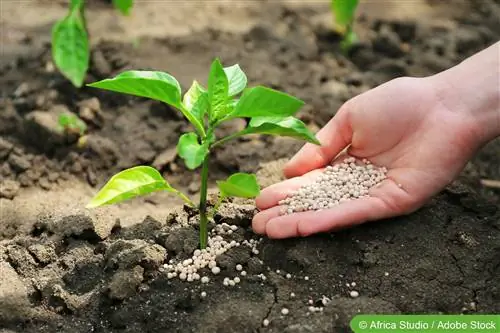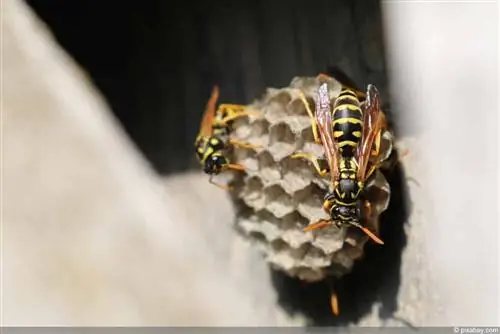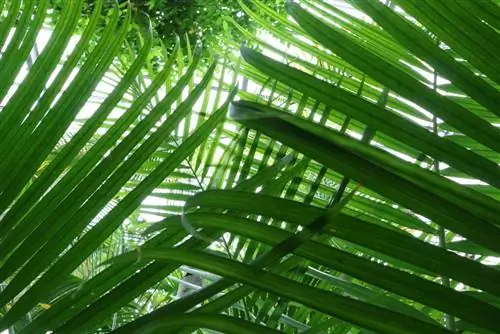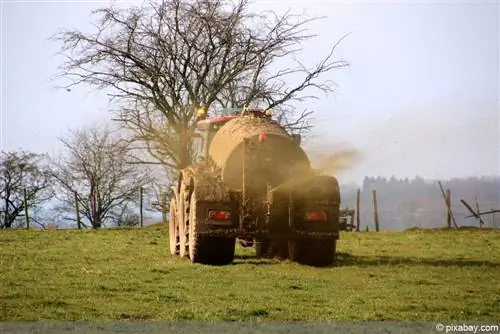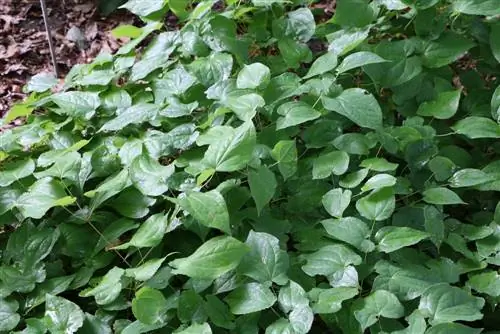- Author admin [email protected].
- Public 2023-12-17 03:39.
- Last modified 2025-06-01 06:48.
If you look for fertilizer for your plants in a garden center or hardware store, you will always come across phosphate fertilizer. At the latest then the questions arise: What is phosphate fertilizer, what does it consist of and what does this term actually mean? Where can and should it be used and when should it be avoided?
Phosphate fertilizer - what is it made of?
As the name phosphate suggests, phosphate fertilizer contains s alts of phosphoric acid. Both people, animals and plants need phosphorus to maintain cell metabolism. This is why phosphorus occurs naturally. Phosphorus is not well soluble in water. In order to be used as plant fertilizer, it must first be processed. The basic material is rock phosphate. It can be obtained from the deposits of decayed marine animals and is a byproduct of iron extraction. In both cases, the raw phosphate obtained is a natural product that is broken down by fine grinding or by using sulfuric acid. The result is a phosphate fertilizer that can be used in the garden and in agriculture.
Phosphate-containing fertilizers for the garden
It is not easy to find out from the large selection of fertilizers which ones are sufficient for use in the garden. Although plants need more than water and carbon dioxide to live, many of the mineral fertilizers on offer contain a lot of nitrate. It cannot be stored by the ground and therefore quickly penetrates into the deeper layers of the soil. This negatively affects the global nitrogen cycle and has a lasting impact on our groundwater. In order to feed the population of the entire world, nitrates cannot be avoided in commercial farming, but your own garden should be fertilized organically if possible.
Organic phosphate fertilizer for the garden
Every gardener should be careful not to pollute his garden soil by using too much mineral fertilizer. There are 'special fertilizers' available in specialist shops for almost every type of plant. With very few exceptions, this special fertilizer only helps specialist retailers. Here is a small selection of phosphate-containing fertilizers that are usually sufficient for use in the garden.
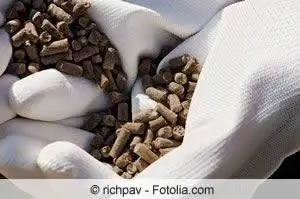
The compost
The optimal form of recycling nutrients is the production of compost. It is not a commercially available fertilizer, but is a particularly good and nutrient-rich additive for the soil. It improves the soil structure sustainably because water and nutrients are stored more optimally. Mature compost contains around 0.1% phosphorus, 0.3% nitrogen and 0.3% potassium. Nutrient levels vary depending on the material being composted. If a lot of small animal litter is composted, the potassium content increases. By composting a lot of poultry manure, the nitrogen and phosphate content increases significantly.
Horn shavings and horn meal
Horn shavings are the grated hooves and horns of slaughtered cattle. When ground very finely it is called horn meal. Both contain about 14% nitrogen and only a little phosphate and sulfate. If possible, horn shavings should be applied in the fall, as this fertilizer only takes effect after about three months. Since horn meal is processed more quickly in the soil, application in early spring is sufficient. When using horn fertilizer, there is hardly any nitrogen leaching due to the organically bound nutrients. Over-fertilization is almost impossible because of the slow onset of fertilization. This is important to know because soil tests repeatedly show that garden soils are oversupplied with potassium and phosphate. Depending on the nutrient requirements of the plants, fertilization with 60 to 120 grams per square meter is sufficient.
Tip:
When planting trees, add a handful of horn shavings to the planting hole. Trees, shrubs and roses will thrive smoothly and magnificently.
Cow manure becomes rot manure
Cow dung is not ideal for sensitive noses. But it is an excellent fertilizer with a balanced nutrient content. The straw portions and other fiber are converted into good humus and thus improve the soil structure. The cow manure should be left to settle for a few months, then the dark color of the resulting rot manure shows that this organic fertilizer can be used. Rottemist contains 0.3 to 0.4% phosphate, 0.4 to 0.6% potassium and 0.4 to 0.6% nitrogen and a wide variety of trace elements. Two to four kilograms of rot manure per square meter should not be exceeded, although over-fertilization is almost impossible. Rotting manure only releases around a third of the nitrogen it contains each year. It is therefore sufficient to only apply it every three years in the fall. Then the rotting manure forms a very good basic fertilizer for perennials, woody plants, vegetable gardens and even for the sensitive rhododendron.
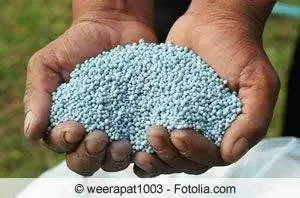
Bluegrain
The classic blue grain fertilizer quickly provides the plants with a lot of nutrients. Unfortunately, the nitrate is quickly soluble and therefore cannot be absorbed by the plants. So it seeps into the earth and pollutes our groundwater. Research has taken on this problem and developed the new blue fertilizer 'Blaukorn Entec'. Now, non-leachable ammonium and special nitrification inhibitors ensure that the ammonium portion of the soil is only very slowly converted into nitrate. The phosphate content has been reduced because most soils are oversupplied with this nutrient for years to come. In private gardens, this fertilizer is available as 'Blaukorn Novatec'. Its use is advisable when a very acute nutrient deficiency occurs.
Tip:
Always use a slightly lower dose than stated in the instructions for use.
Liquid fertilizer for potted plants
The trade offers an incredible number of liquid fertilizers. Low-dose orchid fertilizer, nitrogen-rich fertilizer for green plants and phosphate-rich fertilizer for all balcony flowers and boxes. In the case of cheap liquid fertilizers, the nutrient contents often differ considerably from those stated and in many cases the chloride contents are far too high. That's why everyone is well advised to buy a branded product. Liquid fertilizer should always be used in a slightly lower dosage than stated.
What you should know about phosphate fertilizers in brief
- Phosphates are s alts of phosphoric acid. They belong to the compounds of the element phosphorus.
- Phosphates have a good effect on the fertility of the soil.
- Plants also need phosphorus for metabolism in the cells, just like animals and people.
- Phosphorus is therefore a vital nutrient for every type of living being.
- Unfortunately, phosphates are poorly soluble in water and even if they are present in the soil, plants may not be able to access them.
- It is often necessary to supply the plants with this important nutrient using special phosphate fertilizer.
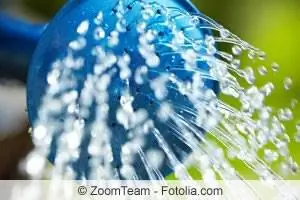
Raw phosphates
Phosphate fertilizer is made from raw phosphates. These are deposits from marine animals that have to be mined, i.e. a raw material from nature, or they arise as by-products of the extraction of iron. In this context, most people are familiar with guano, from which rock phosphates are also obtained. The rock phosphates themselves cannot yet be used to fertilize plants. To do this they must be water soluble. In order to achieve water solubility, they must first be digested. The raw phosphates are either ground into the finest particles or digested using sulfuric acid. Depending on their water solubility, they can then be absorbed quickly or slowly by the plants as nutrients.
- Highly water-soluble phosphate fertilizers are therefore considered to be fast-acting, while the less soluble ones are more likely to be used as long-term fertilizers.
- Since phosphate fertilizer is usually administered in liquid form, the plant absorbs this nutrient through the roots.
- This means they can be easily washed out and have to be replaced regularly.
Phosphate deficiency?
The plant needs phosphate just like potassium and nitrogen. A lack of phosphate can be recognized by slow growth, or rather, the plant remains significantly smaller than other representatives of its species that are sufficiently supplied with phosphate, and also dies earlier. Since phosphate is difficult for plants to absorb, phosphate deficiency is the most common deficiency. Before fertilizing with phosphate fertilizer, you should first check whether this type of plant can be supplied with phosphate fertilizer.

